12.2 Email as a form of e-communication
|
Previous
Chapter 11: The internet and the world wide web
|
Next
Chapter 13: Social implications: email and internet
|
 CHAPTER OVERVIEW
CHAPTER OVERVIEW
| Unit 12.1 | Electronic communication devices |
| Unit 12.2 | Email as a form of e-communication |
| Unit 12.3 | Basic emailing |
 At the end of this chapter, you should be able to:
At the end of this chapter, you should be able to:
- Describe what electronic communication is.
- Describe the different electronic communication devices.
- Electronically communicate using a PC.
- Discuss the different electronic communications.
- Explain the difference between ISP versus web-based email.
- List and explain the different features of email, such as the “Cc” and “Bcc” fields, attachments, and address books.
- Compose email messages.
- Understand how to send, receive, forward, Reply to and Reply to all using email.
- Apply netiquette rules over email.
- Understand email etiquette.
INTRODUCTION
In the past, communication between people was done either face to face, using the telephone, or by writing letters. Now, we live in a world where electronic communication or better known as e-communication has taken over. Think about it, when last did you go to a family or friend gathering and no one took their phones out to message a person? This is how much electronic communication has taken over.
Electronic communication refers to any data, information, words, photos, emojis and symbols that are sent electronically to one or more people. This can be done through emails, social media, newsgroups, chat rooms, video conferencing, instant messaging, phone and fax. With just one click on the send button, you can say “hi” within seconds to your friend in Spain!
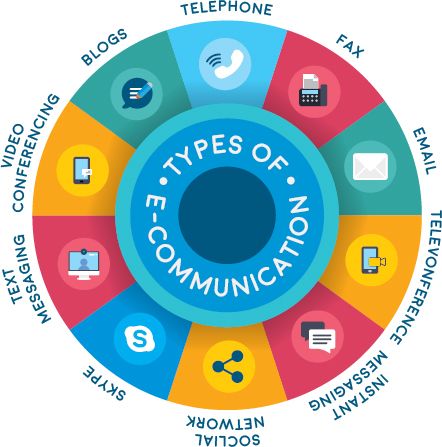
Up to a few years ago, email was the best way to communicate with people online. However, these days there are many other ways to communicate, allowing you to do things such as:
- Making phone calls using your computer
- Sharing the same message with many people at the same time without sending the same message individually
- Interacting with different platforms on the internet and making comments and statuses, or even sending messages
- Seeing the person on the other side of the world you are talking to through video conferencing
In this chapter, we will look at the different electronic communication devices and the different types of applications used in electronic communications. We will also look at email and how to compose and send basic email messages, as well as basic email netiquette.
UNIT
12.1 Electronic communication devices
An electronic communication device refers to any type of computerised device (instrument, equipment, or machine) with software that can compose, read, or send any electronic message using radio, optical or other electromagnetic systems. An electronic message can be a text message, email, an instant message such as WhatsApp, teleconferencing, social networking, Skype, blogs, or even access to an internet site. It can consist of signs, signals, writings, images and sounds, or artificial intelligence (AI).
When people are not communicating online, they make use of phone calls, face-to-face conversations and written letters, depending on each situation. The same applies to online communication; people make use of instant messaging, social networking or email, depending on the situation. You can choose the mode of communication that best suits you.
The following table shows how different people communicate online. We asked Zanele, Linda and Vusi how they communicate online. Their answers were as follows:
Table 12.1: How people communicate online
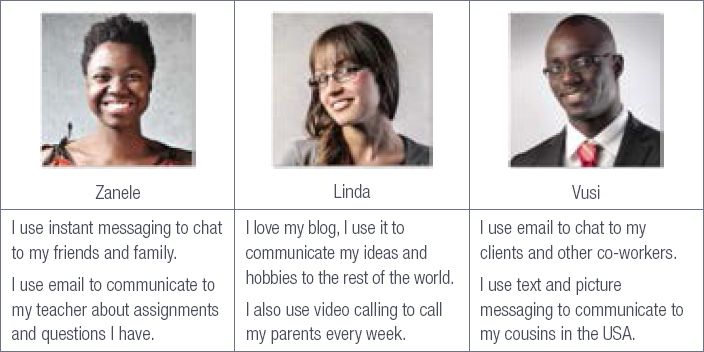
In this chapter, we will look at e-communication using a PC, with specific focus on using and receiving emails.
E-COMMUNICATION USING A PC OR MOBILE DEVICE
There are many ways in which to use electronic communication when you have an internet connection. The most common type would be electronic mail, which is usually referred to as email, but there are also other forms, such as video chat, discussion forums, Skype and instant messaging. In this section, we will look at the different applications that are used to facilitate electronic communication.

Something to know
Have you ever tried to think how many emails are sent per day around the world? In 2017, an average of 269 billion emails were sent and received each day. In 2018, 124.5 billion business emails and 111.1 billion consumer emails were sent and received each day.
One of the first and most popular forms of electronic communication is email, which allows users to send messages and files over the internet. One of the best things about email is that you do not have to wait for weeks to receive it. This type of mail arrives moments after it has been sent.

Something to know
According to recent statistics, teenagers regard email as a more formal mode of communication and they usually use it for school or exchanging messages with adults. Teenagers find emails to be too slow and time consuming, compared to instant messaging.
Email is used in the following ways:
- Communicating with clients or with other employees
- Keeping in touch with friends and family
- Sending files as attachments to another person
- Sending marketing messages to potential clients
We will learn more about emails and how to send them a bit later in this chapter.
MAILING LISTS
Jenny receives an email from Takealot.com every day before 05:00 with their latest sale items and items that they have on promotion. Do you think that someone is sitting in front of a computer sending emails at 03:00 to everyone that subscribed to this website? That is definitely not the case; they use a mailing list.
A mailing list is a collection of names and addresses used by an individual or organisation to send information or materials to multiple recipients. There are two main types of mailing lists:
1. Response list: This list consists of names and addresses of people who have responded to an offer of some kind. Because these people are known responders, their names are generally priced higher than those in lists compiled by other means.
2. Compiled lists: These lists contain the names and addresses of people obtained from telephone directories, public records, direct mail and telemarketing campaigns, etc. This information is sometimes also obtained from a list broker who researches, analyses and evaluates the many individual lists available.
Other types of mailing lists include the following:
- Team list: Mailing lists that teammates use to communicate with each other within their teams
- Group list: Mailing lists used by a specified group of people to communicate with each other, for example a list of the parents of each learner in the school
- Event list: Mailing lists communicating information around a specific event that is happening, such as the upcoming athletics inter-schools event
INSTANT MESSAGING
The internet has changed the way in which we communicate, with email being the most popular form of electronic communication. However, sometimes even email is just not fast enough. Let’s look at the following example to understand this better.

MOST POPULAR INSTANT MESSAGING APPLICATIONS
Watch the following video:

https://www.dw.com/en/the-worlds-most-popular-instant-messaging-apps/av-40684764
INSTANT MESSAGES
In the smartphone-obsessed world in which we live, more people are sending messages through web-based application, such as WhatsApp, WeChat, Slack, LiveChat, Hangouts, Lync, Telegram and Snapchat.
These applications are short messages that are sent and read in real time, allowing you to communicate much quicker than normal emails.
There are also browser-based type instant messaging applications that do not require downloading, for example Facebook and Gmail. These applications allow you to chat to your contacts whenever you are logged in.
Chat and instant messaging are mainly used when both, or all of the people are online so that everyone can read your message instantly, hence instant messaging! An email, on the other hand, will not be seen until the recipient actually checks the email, making instant messaging much more efficient for quick messaging.
Instant messaging is an online chat that allows you to exchange text messages, symbols, pictures and even documents, in real time, over the internet. It also allows you to see if a friend or co-worker is online and apart from sending text messages and files, you can also enjoy video and voice chats.
Instant messaging usually includes a list of your contacts (called a “Buddy List”) which lets you see who is online. This type of messaging is best used when it is one-on-one communication, but it is possible to send several people messages at the same time.
WEB BROWSERS
There are different types of web browsers available, such as Google Chrome, Mozilla Firefox and Internet Explorer. Without these web browsers, it will be impossible to view web pages and websites! In the past, users had to download the software application to their PC so that they can chat, listen to music and watch videos. Nowadays, all these things can be done by just opening the web browser. All you need to do is open a web browser to access a website so that you can communicate via social networks, forums, emails and popular instant messaging services.
Websites are also designed to communicate with the user; whether it is a shopping site that lets their visitors know they have a 70%-off sale, or a small blog where one person talks about the different recipes they try out.

MOST POPULAR ACRONYMS AND ABBREVIATIONS
To check the most popular acronyms and abbreviations when texting, click on this code:

TEXT AND PICTURE MESSAGING
Text and picture messaging are very popular and are usually sent from one smartphone to another. There are, however, applications that allow you to text and send pictures from your computer to a smartphone, or the other way around. Text and picture messages are fast and only take seconds to reach the other person. It is also useful to text someone if it is not possible to call the person, for example if you are in a meeting or in class.
It is easy to send text, pictures or even voice messages through different applications, such as WhatsApp, SnapChat, Facebook, Hangouts and many more.
People can instantly send these forms of multimedia anywhere in the world and it does not cost much.
VIDEO MESSAGING
Video messaging is an easy way to make inexpensive phone calls anywhere in the world and from your computer. It does not even require a very fast internet connection. Many instant messaging and chat services have voice chat and allow you to talk to friends who are online. Video chat lets you see and hear friends, family or clients in real time. Whether you are talking to a friend or someone at work, video chat can add a personal touch to your chats!

Something to know
To decrease the cost of making voice calls, internet companies invented technologies that allow you to make voice calls over the internet (VOIP). Services, such as WhatsApp and Skype, allow you to make free voice calls to other WhatsApp and Skype users.
WEBLOG
Have you ever wanted to create your own website, but never figured out how to? Well you can and best of all it is free and quite easy. Today, it is possible to create a website by creating a blog (short for weblog). So, what is a blog?
A blog is an online diary or journal that is located on a website and presented with the newest information first. It can contain text, pictures, videos, animated GIFs and even scans from old physical offline diaries or journals and other hard-copy documents. Although it is mostly run by individuals or small groups, it can also be run by an organisation, promoting itself and its products or services.
FAX TO EMAIL
A fax (short for facsimile) is an exact copy of a document (text or images) that was scanned and transmitted as data by a telecommunication link. This usually goes to a telephone number that is associated with a printer, or other output device.
Fax-to-email, or email fax, is a system that allows users to send or receive a fax using email. This form of communication is used when you use the internet to send faxes. Basically, what happens is that the sender faxes the document using the receiver’s fax-to-email number, who will then receive the fax as an attachment in his or her email inbox.
 Activity 12.1
Activity 12.1
1. Explain the term “e-communication”.
2. Describe an e-communication device and list three examples.
3. What do you understand by the term “mailing list”?
4. What application do you use the most to text and send pictures? How do you use text messaging?
5. Who normally uses blogs?
6. Vusi has no fax machine. However, his friend from Brazil must fax him a document that he urgently needs. His friend only has access to a fax machine.
a. What can Vusi do to make sure that he gets the document?
b. How do you think Vusi should go about doing it?
UNIT
12.2 Email as a form of e-communication
Email is an electronic form of communication that is exchanged between people through computers, or other electronic devices, such as smartphones or tablets. You need the internet to send emails.
You also need software in the form of an email application that allows you to send, receive, forward and reply to email messages. With emails, you can also attach files, such as documents, photographs and even videos (restricted to a certain data cap).
In this section, you will learn more about email, how email addresses are written, and the features and tools that are included in having an email account.

Something to know
You know that email is a way to send and receive messages using the internet. It is similar to traditional post, but with some important differences. The figure on the left shows what email is about, as well as its advantages.

COMPONENTS OF AN EMAIL ADDRESS
To receive emails, you will need an email account and an email address. To send emails to other people, you will need their email address details too. An email address is, therefore, the unique identifier for an email account.
It is important to understand how to type an email address correctly because, if entered incorrectly, it might not be delivered to the recipient, or it might even go to the wrong person!
Email addresses are always written in a standard format that consists of two parts, a local part or username and a domain-part, separated by an @ symbol. The local part is used by the receiving mail server to determine where the email must go and what must be done with it after it arrived at its destination.
These different parts are called an email’s taxonomy. The taxonomy of the email address, computer@mweb.co.za, is explained below:
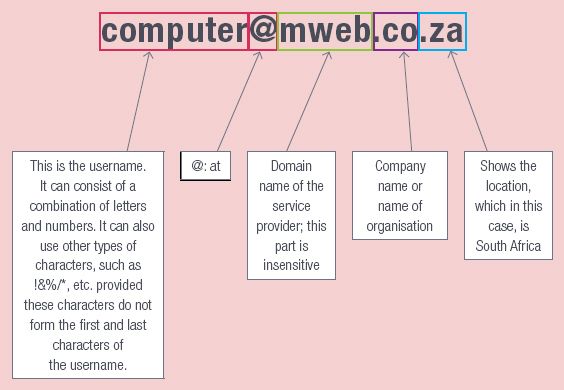
ISP VERSUS WEBMAIL
The first thing to decide when you are looking for an email service provider is whether to use a webmail, or to turn to an ISP to take care of your emails. As both have their advantages and limitations, it boils down to how much money you are willing to spend and the importance of maintaining your email.
Table 12.2: ISP versus webmail
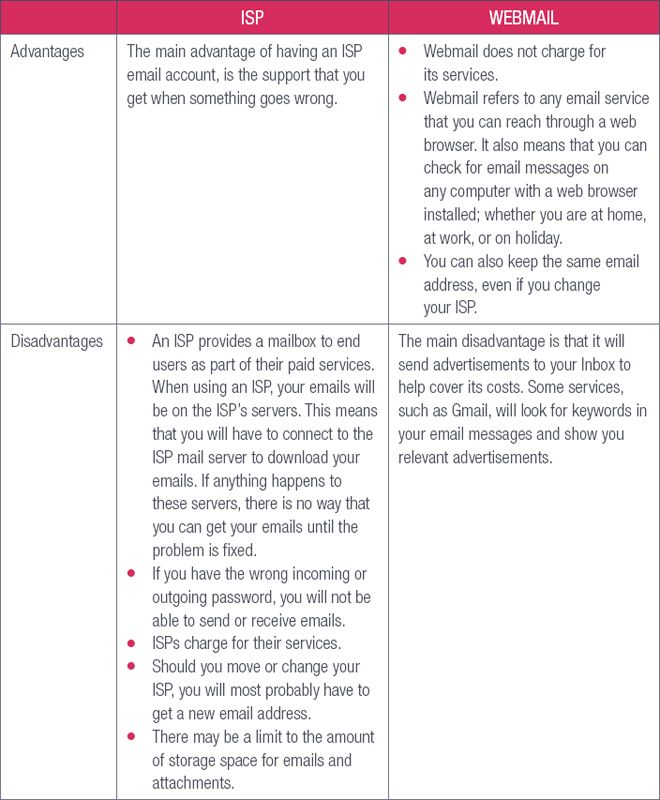
Top webmail providers currently are Google’s Gmail and Microsoft’s Outlook.com. They are the most commonly used as they allow you to access your email account from anywhere in the world, provided that you have an internet connection. You can also access webmail from a smartphone or tablet!
HOW EMAIL WORKS
The following happens when an email is sent:
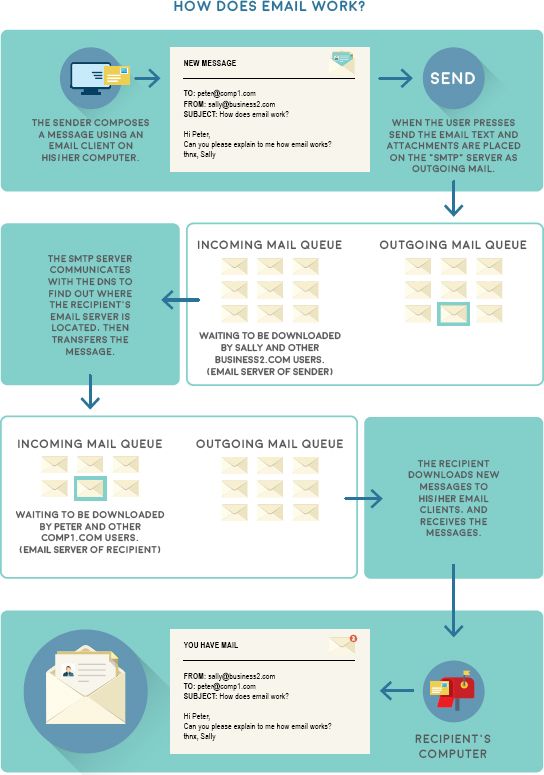
 Activity 12.2
Activity 12.2
1. Which of the following emails in the tables are valid or invalid? Explain why it is invalid each time.
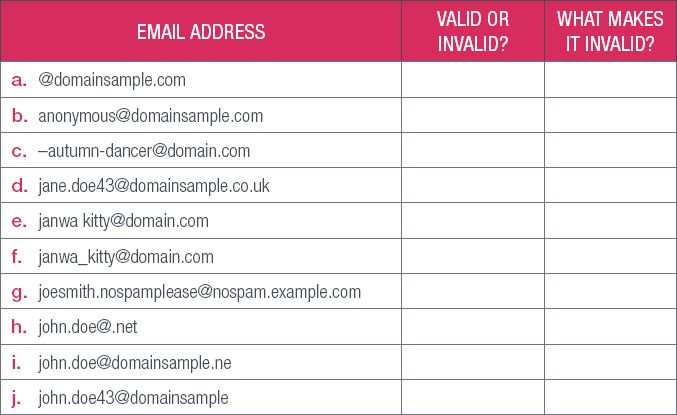
2. What is the difference between an ISP email and a webmail?
3. Give two advantages and disadvantages of ISP and webmail.
UNIT
12.3 Basic emailing
Before composing and sending email messages, you first need to know how to use an email account. In this section, we will use Gmail to show you the basics of using an email account. If you decide to choose another email provider, the interface might be different, but the basics will still be the same. You will learn how to:
- Sign up for an email account
- Navigate and familiarise yourself with the user interface
- Compose, respond, receive and forward email messages
In this section, we will look at the email interface, the terms and actions used in email, as well as features commonly used with email.
EMAIL INTERFACE
Whichever email service provider you choose, you will still need to get to know the email interface. This includes the Inbox, Message pane and Compose pane. Although the interfaces will look different depending on the email provider, in the end, they all function in the same way.
INBOX
The Inbox is where you will see and manage any emails that you receive. Emails are listed according to the date or time received, the name of the sender and the subject of the email message.
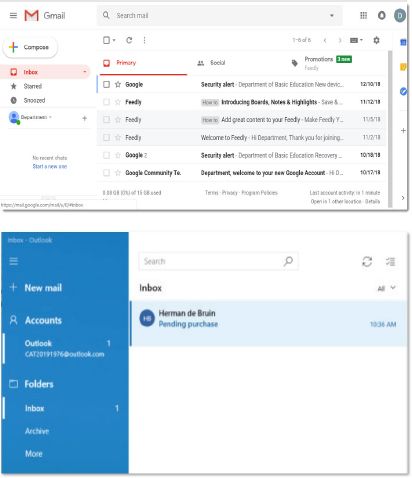
MESSAGE PANE
After you select an email in the Inbox, it will open the Message pane where you can read it and then choose how to respond, using a variety of commands.
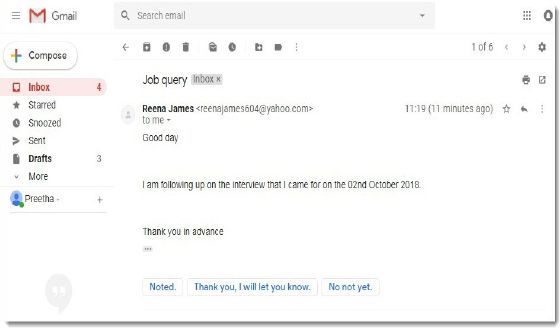
COMPOSE PANE
When you click on the Compose button from the Inbox, it will let you create your own email message. From here, you will have to enter the recipient’s email address and a subject. If you need to upload files, such as photos or documents, you can do that by adding an attachment.
Figure 12.7 shows the different parts of the Compose window.

A: Recipients are the people to whom you are sending the email. For each recipient, you will have to type in the email address. In most cases, you will add recipients to the “To: Field”, but you can also add recipients to the “Cc”: or “Bcc”: fields.
B: Cc stands for carbon copy and is used when you need to send an email to a person who is not the main recipient. It helps to keep everyone updated, but at the same time, it lets the person know that he or she does not need to respond to the email. Bcc stands for blind carbon copy. It is almost the same as Cc, but the email addresses in the Bcc fields are always hidden. This type of emailing is perfect if you need to send the same email to a large group of people, but keep their email addresses private.
C: The subject of the email is used to say what the email is about. The subject should be short, but clearly state what the message is about.
D: This is the body of the email. The body of the email is the actual text of the email, similar to that of a normal letter. It starts with a greeting, adds a paragraph or two and ends with a closing statement with your name at the end of it.
E: An attachment is a file, for example an image or document, that can be sent along with the email message by clicking on the Attachment button. Gmail allows you to attach more than one file, as long as it is not bigger than 25 Mb in total. However, by integrating its cloud storage service, Google Drive with Gmail, it is now possible to attach files as large as 10 Gb.
F: The Formatting button allows you to access the different formatting options for example, changing the font colour, look and size of the message, as well as include hyperlinks.
G: When you are happy with the message, you can click Send to send it to the recipient(s).

Something to know
If the details of person that you are sending an email to is already in your address book, then you can actually start by typing in the person’s first name and Gmail will display the contacts below the “To:” field. Then press Enter to add the person as a recipient. This saves you time from actually typing in the whole address.
SENDING EMAILS
Now that you have created an email account and understand how the email interface works, you can start sending email messages.
In this section, we will look at how to compose an email, add an attachment, reply and forward emails.
When you type an email, you will be using the Compose window. In this window, you will add the email address of the recipient(s), subject and the message itself. You will also be able to add one or more attachments in this window.

HOW TO SEND AN EMAIL
 Guided Activity 12.1
Guided Activity 12.1
Do this activity in your class. Your teacher can help guide you in creating an email account. Use the account you created for this activity.
To send an email, you can do the following:
1. Click on the Compose button found in the left-hand pane.
2. The Compose window will appear on the right-hand side of the page.
3. In the “To” field, add one or more recipients. This is done by either typing in the email addresses manually, or by using the Address Book.
4. Type a subject for the email message.
5. Type a message in the body field. When done click Send.
ATTACHMENTS
An attachment is a file, image, or document that is sent with the email. For example, if you are applying for a bursary, you can send your results and other documents as an attachment, while the body of the email serves as the covering letter. It is always a good idea to let the recipient know that you have attached a file or files.

Something to know
Always remember to attach the file before sending it, it is extremely common for people to send an email without actually attaching the file!
 Guided Activity 12.2
Guided Activity 12.2
Let’s look at how to add an attachment. Do the following activity in your class with the help of your teacher.
1. When you are writing the email, click on the paperclip (attachment icon) icon at the bottom of the Compose window.

A dialogue box will open with files that you can choose to attach.
2. Choose the file you want to attach and click Open.
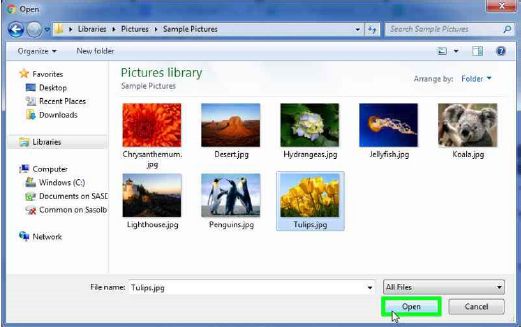
The attachments will then start to upload. Most attachments just take seconds to upload. Large attachments can take longer.

3. When you are ready to send the email, just click Send.
You can click on the Send button before the attachment is finished uploading.
REPLYING TO EMAILS
Emails are not only sent; they are received as well. After reading an email, there are certain actions you can take, for example, replying to the message, forwarding the email to someone else, or opening an attachment if there is one.
READING EMAILS
Any email that you receive will be in the Inbox and you can tell which emails are unread, because they are marked in bold. From the Inbox, you can see the name of the sender, the subject of the email, as well as the first few words of the email. This means that, before you even open an email, you can already gauge a few things about it.
 Guided Activity 12.3
Guided Activity 12.3
Do the following activity in your class with the help of your teacher. This activity will help you learn how to read an email:
1. Go to the Inbox and click on the email you want to read.
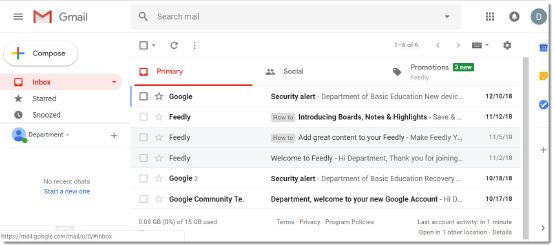
The email will then open up in the same window:
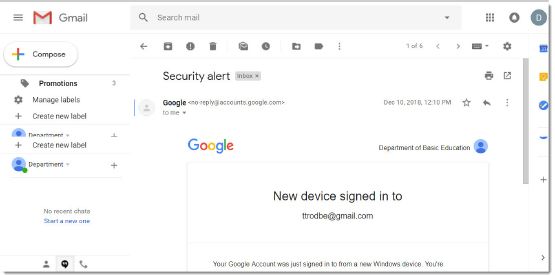
After reading the email, you can choose to Reply, Reply to all, or Forward the email to someone else. To perform any one of these actions, click on the three-dot icon found on the right-hand side of the email window.

REPLY, REPLY TO ALL AND FORWARD AN EMAIL
What is the difference between Reply, Reply to all and Forward?
Table 12.3: The difference between Reply, Reply to all and Forward in an email
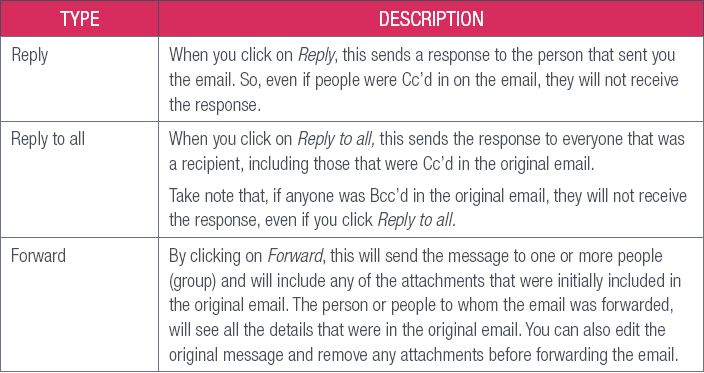

DEALING WITH EMAILS
To understand more about the different actions you can take after reading an email, watch the following video:

ATTACHMENTS
There are times when you will receive an email containing attachments. To view the attachment, you will need to download it. In some cases, for example if the attachment is a Word document or an image, you can view it in the web browser.
In the Inbox, even before opening the email, you can tell if the email has an attachment by looking for a paperclip icon to the right of the subject.

Something to know
You should only open attachments from a trusted source. Some attachments could contain a virus, especially if it ends with the .exe in the file name.


HOW TO ADD A HYPERLINK
Have a look at these videos on how to add a hyperlink in Outlook and Yahoo Mail:

https://www.youtube.com/watch?v=OFIFZ6-xuJc

HYPERLINKS IN EMAILS
Hyperlinks are added to emails so that the recipient can follow a link to visit a particular website or web page. Many businesses send emails with hyperlinks to promote or market their services or products. Note that the concept of how to create a hyperlink might be different in the various email applications.
 Guided Activity 12.4
Guided Activity 12.4
Do this activity in your class with the help of your teacher. This activity will look at how to create a hyperlink in Gmail.
1. Sign into your Gmail account and compose an email to create a new message, or you can reply to an email that is already in the inbox.
2. Click on the Link icon in the Gmail toolbar, which is usually found next to the paperclip icon.

3. After clicking on the hyperlink icon, a dialogue box will appear asking you to insert the Text to Display and the Web address.
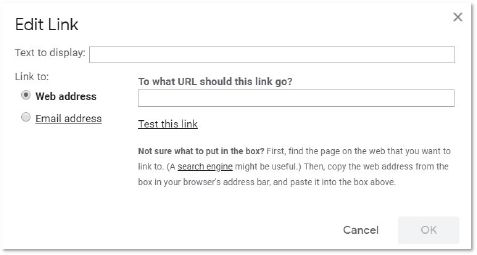
4. Enter the web address link you want the recipient to open in the To which URL should this link refer? field, such as “www.cnn.com”.
Then enter the text you want the hyperlink to appear as in the Text to display field, such as News. Then click OK.
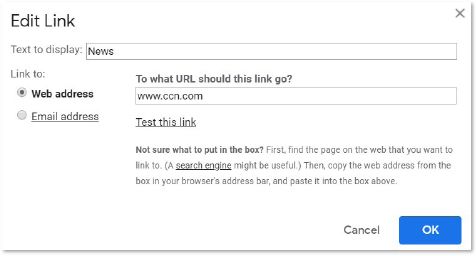
The link will then be added in the email, usually in a different colour and underlined so that the recipient knows that it is a link. The recipient can then click on the link and the link will open in another tab.
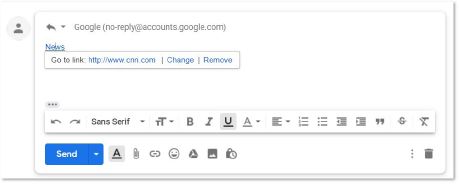

Something to know
By pressing Ctrl+K in Gmail, the hyperlink dialogue box will open immediately.
ETIQUETTE IN EMAILS
As with any other form of communication, it is always important to practise good netiquette in emails. Netiquette is short for network and email etiquette. Netiquette means to use good manners when communicating electronically, or when using the internet; whether it is in the workplace, or on a personal level. It is also about respecting other people’s privacy.
In this section, we will look at email etiquette, as well as why spelling is important when sending emails. Look at the following guidelines to practise good netiquette:
- Messages: Do not spam people at work, your friends or family with unwanted email messages or chain emails. Spam refers to unwanted or irrelevant messages that are sent over the internet or through emails.
- Concise: Make sure that when writing emails, they are clear and to the point. Also make sure that they do not contain spelling and grammatical errors.
- Subject line: Make sure the subject line is clear so that the recipient knows what the email is about.
- Identify yourself: Always say who and what you are at the beginning of the email and add a signature with your phone number at the end of the email.
- Action required: Let the recipient know right away if any action is required from his or her side. You can do this by marking emails that do not require any action with “FYI” in the subject line.
- Capital letters: Do not type emails in capital letters as it gives the recipient the idea that you are shouting.
- Exclamation marks: Avoid using exclamation marks or if really needed, use them sparingly. The use of exclamation marks sends a message to the recipient that you are demanding.
- Large attachments: Compress large files before sending them. This helps the recipient to save time instead of waiting for a long time to download files. You can always ZIP or compress files (as learned in Chapter 5) to make it easier to send.
- Gossip, inflammatory remarks and criticism: Avoid gossiping about others through email, especially at the workplace. Also, do not send insulting, abusive or threatening emails. You cannot withdraw such an email and it can easily be forwarded to unintended recipients. This could lead to unnecessary disputes and grudges in the workplace and in a personal environment.
- Focus on what is in the email: Make sure that you read the email properly and address the sender’s questions.
- Proofread the text: Before sending the email, read through it again to make sure that it is saying what you want it to say and that there are no spelling and grammar mistakes.
 Case study 12.1
Case study 12.1
Julie works at a big auditing firm and deals with different clients on a day-to-day basis. She has made good friends with people at work, so occasionally she gets funny emails from them. However, she found one email to be extremely funny and decided to send it to her friend who works in another company. She just added the friend’s name and after a few clicks, the email was sent.
In the space of five minutes, she got some out-of-office replies. She did not realise that she had sent it to all the staff in her department and worst of all, she sent it to her senior manager.
This is an example of the email she sent.
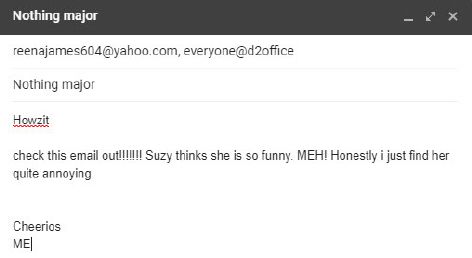
1. What is the first problem with this email?
2. Discuss two email etiquette rules that are broken by Julie.
3. Explain what Julie can do to save her reputation.
SPELLING AND EMAILS
Spelling is important in emails; whether it is emailing your manager, a co-worker, teacher, or even a friend. You need to make sure that you are sending an email that has no spelling errors. Sending an email with spelling errors does not reflect well on you.
Did you know that your email application has a Spell Check tool that is used to correct spelling mistakes when writing an email? In some applications, if a word is spelt incorrectly, it will be underlined in red or green wavy lines. By right clicking on the misspelt word, you can choose the corrected word from the Context menu.
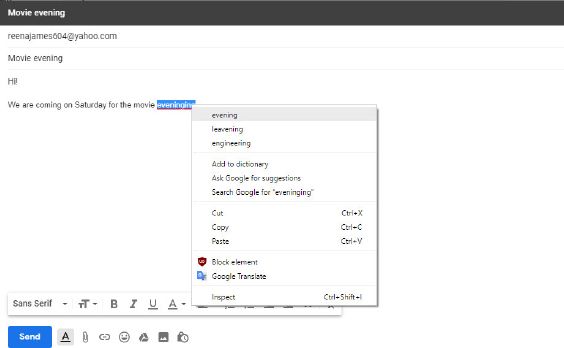

Something to know
According to Emily Gorton, HR assistant at Powder Byrne Travel Agency, it is a cardinal sin getting someone’s name wrong in an email. It shows a lack of interest and no attention to detail, and can negatively change a person’s impression about the sender. The best thing to do then is to own up and apologise by sending another email as soon as possible.
It is always important to read the content and grammar of an email before sending it off. Something as small as making an error in someone’s name, can make a very big difference in the way people perceive you.
In some email applications, you can enable the Spell Check function. This will automatically correct any spelling or grammatical errors.
 Activity 12.3
Activity 12.3
1. When sending a file as an attachment via an email, the email bounces back and displays the following message:
This is the mail delivery agent at messagelabs.com.
I was unable to deliver your message to the following addresses:
Reason: 552 Message size exceeds maximum permitted
a. Why did the error message occur?
b. Briefly describe how the error can be fixed.
2. Study the following email:

a. Compare the  and the
and the  section in the email.
section in the email.
b. Consider the context of the email message on page 196 and list two email etiquette (netiquette) rules that have been violated.
3. Read the following scenario and answer the questions that follow:
The Motaung family’s ISP is Polkadot. As part of their contract, the Motaung family receives one free email address. Should they need more email addresses, they need to pay an additional fee per month for each additional email address. Mrs Motaung’s business’s name is Haybo! Catering.
a. Suggest a suitable email address for Mrs Motaung’s business. Motivate why you suggested this email address.
b. Suggest how Mr Motuang could get his own email address at no cost.
REVISION ACTIVITY
1. Explain what is meant by “e-communication”. (3)
2. Write a short paragraph to explain the difference between email and instant messaging. (4)
3. Study the following screenshot and use it to answer the questions that follow:

a. What is the username of the email address in the Bcc field? (1)
b. What is the domain name of the group to whom the email is being sent? (1)
c. The email address designteam@weborg.co.za is being sent to a mailing list.
Explain what is meant by a mailing list. (2)
d. Will the members of the design team know that the email has been sent to their manager? Explain your answer. (3)
4. Innocent has two email accounts. The email addresses are innocent25@gmail.com and inno.mhlebi@mweb.co.za.
a. Which email address is a web-based email account? (1)
b. List one advantage and one disadvantage of having a web-based email account. (2)
c. What is the domain name of Innocent’s ISP? (1)
5. Amahle is a long-distance runner who participates often in marathons.
a. Amahle would like to keep an online journal of her experiences. What e-communication application should she use? (1)
b. Mention two things that she could write about each day. (2)
6. Study the screenshot of an email below and use it to the answer the questions that follow:

This email does not follow good netiquette.
a. What is meant by “netiquette”? (2)
b. Mention three ways in which the writer has not followed good netiquette. (3)
TOTAL: [26]
AT THE END OF THE CHAPTER
Use the checklist to make sure that you worked through the following and that you understand it.
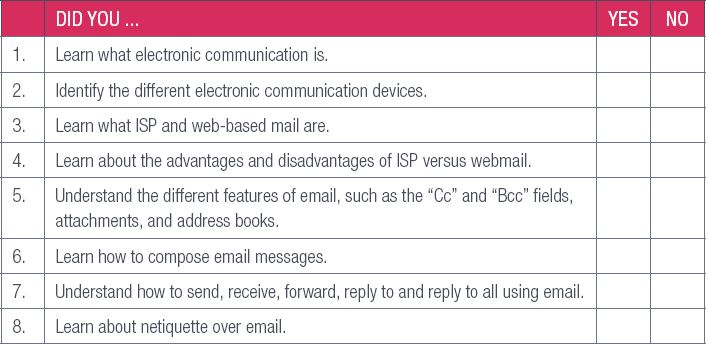
|
Previous
Chapter 11: The internet and the world wide web
|
Table of Contents |
Next
Chapter 13: Social implications: email and internet
|


